When we received our Gold Rights Respecting Schools banner we had to take down our silver one. We wondered what we could do with the old banner. We decided to repurpose it into a giant paint easel outside!
Doesn’t it look great!
By Mrs Russell
The turnips that we planted in the spring time were growing very big and one of the children commented
“it’s like the story of the big turnip that was pulled by the dog and man and boy and girl”
Some of the children hadn’t heard the story so we read the story together. We also watched a video of the story.
At last the time came when our enormous turnip was ready to pull up.
“We are going to need a lot of children to pull up our turnip.”
We later made turnip soup and also tried some mashed turnip.
Planting and growing our own vegetables helps us build our understanding of where our food comes from.
We were also developing our early literacy skills as we compared our own experience to the story.
We have achieved our 8th ECO-Schools Scotland Green Flag Award!
We are delighted to receive such positive feedback including
“I really like that your children took part in your Environmental Review.”
“It is wonderful to see you learning to grow your own food.”
“I really like your emphasis on your children learning about people from different cultures and backgrounds and how they can help those in need.”
“You have done a great job involving your local community in your Eco-Schools activities.”
“I really like your Eco-Code, as it is so catchy!”
by Mrs Wilson
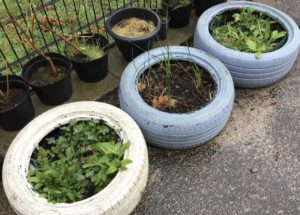 Last year we planted some wildflower seeds in tyres in the garden and seeds from these plants have started growing this year. The children were keen to plant some more wildflower seeds and we decided to do this by first making some seed balls.
Last year we planted some wildflower seeds in tyres in the garden and seeds from these plants have started growing this year. The children were keen to plant some more wildflower seeds and we decided to do this by first making some seed balls.
Seed balls are a really great way to plant wildflower seeds in your garden or outdoor area. Making the seed balls will not only introduce children to the variety, shapes and sizes of different seeds, but also develop their gardening skills as they learn about what seeds need to grow and how they can support wildlife in their garden or outdoor area.
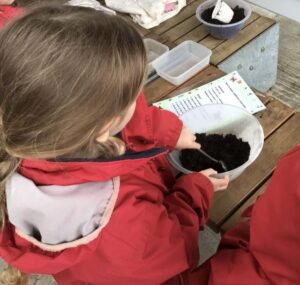
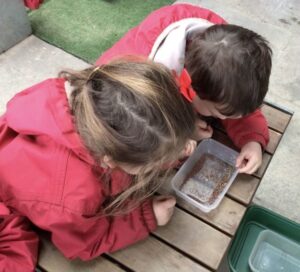
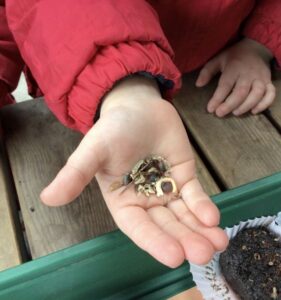
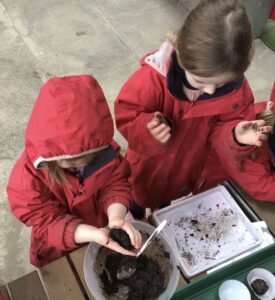
“The bees will like these flowers when they grow.”
After planting and watering the seed balls the children are now looking forward to observing the wildflower seeds grow and hopefully welcoming some bees and butterflies and other creatures into our garden.
When the wildflowers have grown they will add a variety of colours where they have been planted, providing food and shelter for insects and other creatures. Wildflowers are also greatly important for pollinators such as bees so they can carry pollen from one plant to the next.
Why not have a go at home by following our recipe and help support wildlife in your area, or try the recipe below to make recycled paper wildflower seed balls.
https://scottishwildlifetrust.org.uk/resource/make-recycled-paper-wildflower-seed-balls/
by Mrs Wilson
The strawberry plants that we planted in April have finished producing fruit so we have been very busy caring for our strawberry patch.
We have been weeding out some grass that has grown there and cutting off leaves that have turned brown.
We noticed that lots of runners have grown from our strawberry plants and we have been learning how to plant these using compost, pots, trowels, dibbers and watering cans, so that we can grow new strawberry plants.
One of the children thought it would be a good idea to make a new sign for our strawberry patch so we used some old wood and acrylic paint to make a new one.
We have also been developing our awareness of how we can care for the environment by reusing and recycling different items. We made our own plant food by cutting up banana skins, left over from snack, into small pieces and adding them to old bottles filled with water. After a few days, the banana water will be ready to use as plant food to help our strawberry runners to grow.
We harvested some of the potatoes we have been growing in our garden.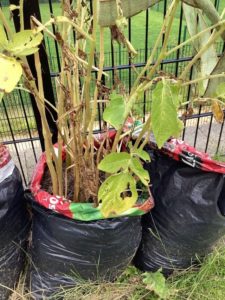
We boiled them to make some yummy mashed potato and used the leftovers to make potato scones for snack. So tasty!
Why not try our recipe at home-
450g floury potatoes, peeled and cooked
1/2tsp salt
50g butter
100g flour
1. Mash potatoes,add salt, butter and flour to give a stiff mixture.
2. Turn out onto floured surface, knead gently and roll out to a thickness of 1cm.
3. Cut into triangles and cook on a hot greased griddle for 4-5 minutes on each side.
I wonder what we will make next….
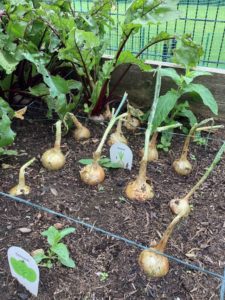
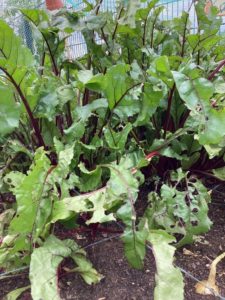
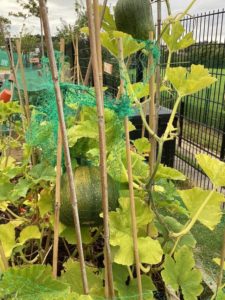
by Mrs Burnett
Continuing our theme of Spring planting, what a lot we have learned from simply planting a few little sunflower seeds.
Back in March, to set the stage for World Down’s Syndrome Day we used fundraising seed bags donated by one of our lovely children, to sow some sunflowers indoors.
We scrutinised the differences between the seeds of the normal yellow sunflowers and a new red variety we had discovered.



We carefully followed the instructions on how to plant the seeds, learning what plants need to grow.
Keen to learn what was happening to our seeds under the soil, we looked at fact books about sunflowers and watched time lapse videos of the sunflower life cycle on the iPad.

We have been checking our pots regularly and when the sunny weather came, we transferred them to a sheltered spot in the garden. We ordered them by size and gave each one a number and a name including Bonzo, Sunny and Apple Crumble!
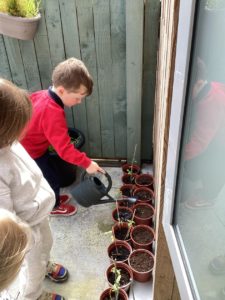

Developing our numeracy skills, we have been having a go at estimating and then measuring the sunflowers’ height progress, plotting the results on a chart.
During a sunflower health check, we spotted that two plants had mysteriously lost their leaves. On closer examination we noticed a rogue slug and problem solved together…

“It’s just a baby one.”
“It will eat our sunflowers.”
“We have to take it away from Bonzo!”
“Maybe we could put it in the bug hotel for a holiday?”
Having gently relocated the slug off on its holidays and continuing to provide Bonzo and friends with tender loving care, we are trying hard to be patient as we wait for our sunflowers to bloom.
Roll on summer 😎
by Mrs Wilson
The children have been very busy over the last few weeks planning and preparing everything we need to get ready to start planting in our nursery garden.
We made a floor map to add our ideas about what we needed to do and what we would like to grow.
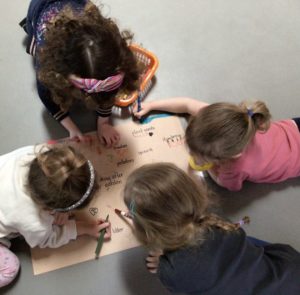
One of the ideas from the floor map was to plant pumpkin seeds so we could grow our own for Halloween. We learned that pumpkin seeds are planted on their sides and when they are growing they will need lots of water.
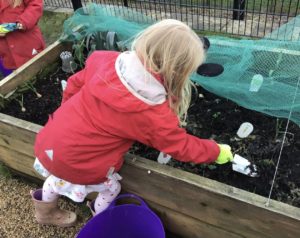
We have been developing our fine and gross motor skills as we used trowels to dig out weeds and turn over the soil in our raised beds so the soil is prepared for planting. Some of the children remembered that last year some of our plants were eaten by slugs, so we decided to go on a slug hunt in the garden so we could remove them.
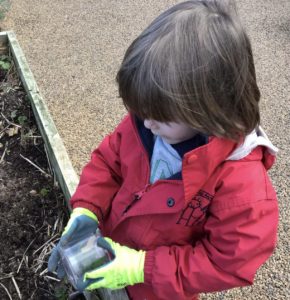
Using soapy water and sponges we washed out old plant pots so they are ready for planting our new seeds.
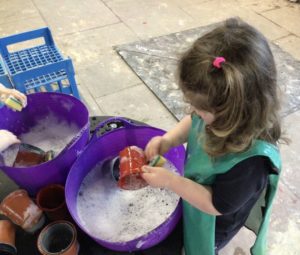
Potatoes are always a favourite to grow with the children at our family centre. We used our observation skills and magnifying glasses to learn about chitting seed potatoes to allow the eyes to grow before we can plant them.
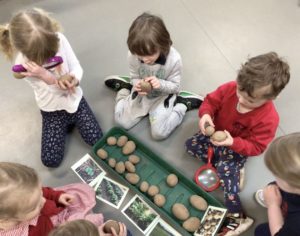
To decide what we are going to plant we used buttons to choose our three favourite fruits or vegetables to grow in the garden.
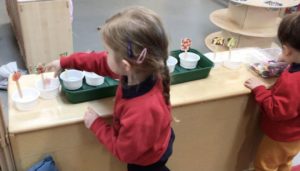
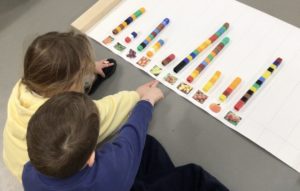
We made a graph using unifix cubes to help interpret the results of our fruit and vegetable survey.
The children are now looking forward to planting in the garden. This will help to develop their knowledge and understanding about how the different plants grow and how to look after them, as well as the opportunity to taste a variety of fresh fruits and vegetables when they are ready to harvest.
Further information about growing fruits, vegetables and flowers and gardening with children can be found on the following websites:
https://www.rhs.org.uk/education-learning/gardening-children-schools/family-activities/grow-it
https://www.gardenersworld.com/plants/tips-for-gardening-with-children/
We are delighted to have received our 7th Eco Schools Green Flag. This is a wonderful achievement and has been down to the hard work and commitment of the children, staff and wider community of Glenwood. 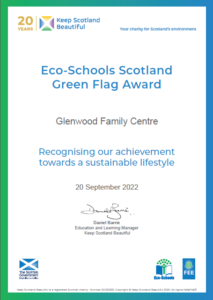
Read the wonderful feedback here.
by Mrs Wilson
The children and adults have been learning about planting, growing and harvesting a variety of different vegetables and fruit with help and support from Goody Foody. Towards the end of August we began to harvest our beetroots and the children have been exploring them in their play experiences.
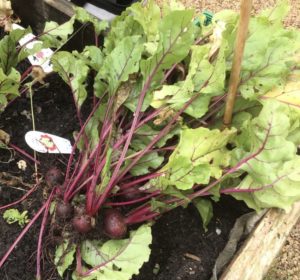 The children have been learning how to prepare the beetroot for cooking, using brushes and water to clean them and joining in with a rhyme as an adult used a sharp knife to cut off the bottom and cut the leaves off the top.
The children have been learning how to prepare the beetroot for cooking, using brushes and water to clean them and joining in with a rhyme as an adult used a sharp knife to cut off the bottom and cut the leaves off the top.
Chop, chop, choppity-chop,
Cut off the bottom, and cut off the top.
What there is left, we put in the pot.
Chop, chop, choppity-chop.
When the beetroots were cooked the children had the opportunity to have a go at tasting them.
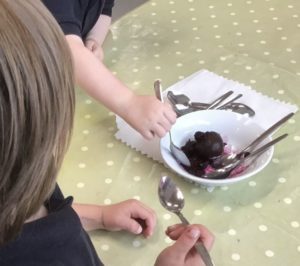
The children were very interested to observe that the beetroot cooking water had changed colour.
“It looks a bit like purple now. The beetroot has changed the water.”
The cooking water was used to investigate what would happen if some white cotton material was soaked in it.
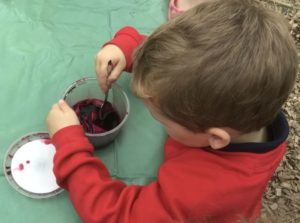
The children developed their mark making skills using the cooking water to paint with.
The beetroot leaves were also used, along with some nasturtium flowers and leaves grown in the garden, to try the Japanese art of Hapa-Zome (leaf-dye).
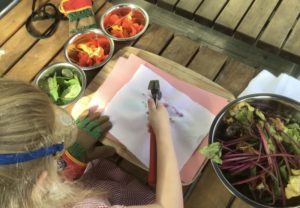
The children have been learning about making life and the impact rubbish can have on animals living in the water! Let’s dive in and take a closer look at what they learned..
“700 is like the whole sea! We need to save them before they get extinct like the dinosaurs”
“If we save one fish from every type then we can save them all next year and all the years after that”
“If a fish or a birdie gets stuck in a net then it can’t move and be safe”
“Nets stop swimming”
“Babies and children like me can suffocate with plastic bags and so can fish and birds!”
“If they eat it and don’t mean to they get sick and sad”
“Some fish accidentally eat plastic bottle tops and straws because they think they are food”
We asked our nursery friends some questions about what rubbish they see on their way into nursery. After seeing the results we used recyclable materials to create a ‘3D’ poster of ways rubbish affects the sea life.
“We made a rainbow fish with masking tape, bottle tops and wooden sticks to show all the rubbish pollution”
“The nets are making the fish sad because they get trapped in them all of the time and they can’t get out”
“Nets get fish trapped”
“Plastic bottle tops make the fish sick because they think that they are food to eat”
What can we do to help? Here are the children’s ideas…
“We can make paper straws by rolling up paper and then we can recycle them”
“We can keep the grounds clear by not littering”
“We can go on a litter pick with our mums and dads and we can do them in nursery too”
“We need to work together with team work to help the oceans get free from plastic”
“We can have a plastic bottle bag to collect the, all at the door and use them for junk modelling”
#source2sea #KeepScotlandBeautiful #LfS
The children have been very interested to learn about planting and growing runner bean seeds for our new family centre. By placing a runner bean seed in a zip lock bag with some wet cotton wool and sticking this on to the window, the children were able to observe the seeds germinate as the roots and shoots started to grow.
“I can see the roots going down and the shoots going up.”
“They are going to be so tall.”
“The roots are getting really long now.”
After about 10 days the children filled some small plant pots with soil and carefully planted a seedling in each one and then watered them all.

“I will give them some water. They need water so they can grow.”
The children took responsibility for checking that the soil in the pots was not too dry and made sure each plant had enough water to help it grow.
“The beans need a little drink of water. I touched the soil with my finger and it felt dry.”
To prepare for planting the runner beans outdoors a handheld drill was used to drill drainage holes in planters, the planters were filled with soil and canes were added to provide support.
“I’m turning the handle round and round. I can see little bits of plastic at the bottom.”
To help carefully remove the plant from the pot without damaging it, the children learned about gently rolling and squeezing the pot with their fingers and hands. They were very interested to see how the roots had grown inside the pot.
“Look at all the roots. There are so many.”
When the children had finished planting all the runner bean plants they chose a sunny spot to put them in the garden and gave them a big drink of water.
“The beans are really tall. They have lots of leaves.”
Further information about growing runner beans can be found on the following website: https://www.gardenersworld.com/how-to/grow-plants/how-to-grow-runner-beans/

As a nursery community, we are on a continuous journey to empower our children to improve their environmental awareness.
There are lots of wonderful ideas that you can do as a family to learn more about the natural world and care for the environment, which supports STEM and literacy learning, as well as your child’s health and wellbeing.
Introduce your children to the concept of sorting household rubbish for recycling into categories such as plastic, paper, metal and glass. This is a fantastic opportunity to learn about different types of materials used for packaging, how they are made and how they can be reused.
National Geographic have a great online game to do a recycle round-up and clean up the park: https://kids.nationalgeographic.com/games/action-and-adventure/recycle-roundup-new/
Instead of throwing things away, encourage your child to think of great ways to reuse items. Egg cartons work really well for growing herbs, glass jars are perfect for storing loose parts for play, and tin cans make really good pen and pencil holders.
COMPOST
Composting helps to teach our children about reducing the waste that heads to landfills by converting it into nutrient-rich soil.
There are lots of free and easy ways for your family to start composting.
Use a recycled plastic drinks bottle – https://www.changeworks.org.uk/sites/default/files/Make_compost_in_a_bottle.pdf
Recycle some wooden pallets – https://www.rspb.org.uk/get-involved/activities/give-nature-a-home-in-your-garden/garden-activities/startcomposting/
You could also simply create a compost trench in your garden or use an old bin or container – https://aggie-horticulture.tamu.edu/Kindergarden/kidscompost/CompostingForKids.pdf
So what should you put in?
 Greens – these are things that rot quickly, and provide important nitrogen and moisture
Greens – these are things that rot quickly, and provide important nitrogen and moisture
Browns – these are things that rot more slowly. They provide carbon and fibre and also allow air pockets to form
Visit a local park and spend some time cleaning up the litter. You will not only be protecting the wildlife and caring for the world around you but you will also be helping your community. It will hopefully inspire others to join in too. Count how many bits of rubbish you find – you will be amazed! Don’t forget to wear protective gloves and take a rubbish bag.
You don’t have to go far to encounter some amazing living things. Going on a back garden safari in your own garden or to a local park or woods will be a real voyage of discovery. It is such a fun way to explore and learn about local plants, animals and minibeasts. You can simply sit and watch, take photos or a video, do a scavenger checklist or record what you found by drawing a picture.
There is lots of information on the WWF to help you get started – https://www.wwf.org.uk/learn/love-nature/garden-safari
GROWING FRUIT AND VEGETABLES
Getting your child involved in growing fruit and vegetables is a great way for them to learn where their food comes from and make healthy eating choices. Children can see first hand the growing cycle and develop an awareness of the seasonal nature of food.
Try growing indoors whilst the weather is still cold. Tomatoes, carrots, peppers and beans work well on a nice sunny windowsill using a recycled container that allows drainage.
https://kidsgardening.org/gardening-basics-indoor-gardening/
 Spring is coming soon and the perfect time to start growing outdoors if you have the opportunity. You can plant in tubs, make a raised bed or create a garden growing patch.
Spring is coming soon and the perfect time to start growing outdoors if you have the opportunity. You can plant in tubs, make a raised bed or create a garden growing patch.
Fruits and vegetables that are easy to grow and mature quickly are strawberries, lettuce, peas, radishes, and courgettes.
https://www.bbcgoodfood.com/howto/guide/easy-crops-kids-grow
We would love if you could share your learning from home with us so we can use it as part of our action plan, either via Google Classroom or Twitter @GlenwoodFC #Glenwoodlearningfromhome
We are delighted to have successfully attained our 6th Eco-Schools Green Flag Award!
This is a brilliant achievement and is the result of sustained hard work and commitment by the Glenwood community.
See our video of evidence below.
Mrs Silvester has been having fun with her recycling again! Here are some ideas of things you could try at home too…
Catapults
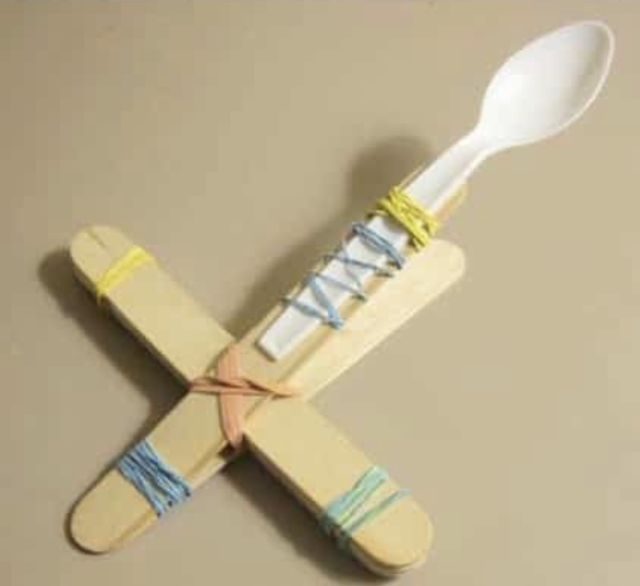 In Mrs Silvester’s house we set out to build our own catapults with things we had around the house to see if we could create our own trajectory devices. Then we built a basketball type game with the catapults.
In Mrs Silvester’s house we set out to build our own catapults with things we had around the house to see if we could create our own trajectory devices. Then we built a basketball type game with the catapults.
Here are some of the things you could use: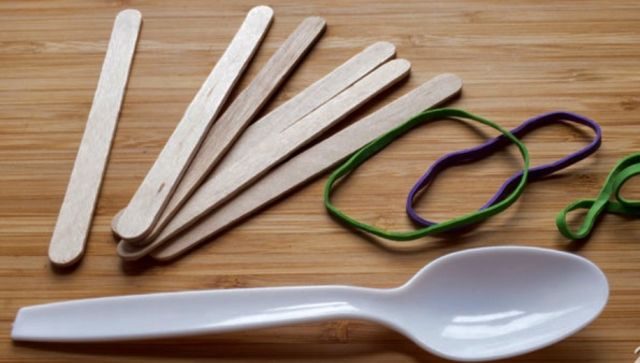
These were some of the questions the children in my house had, which we were hoping the experiment would answer:
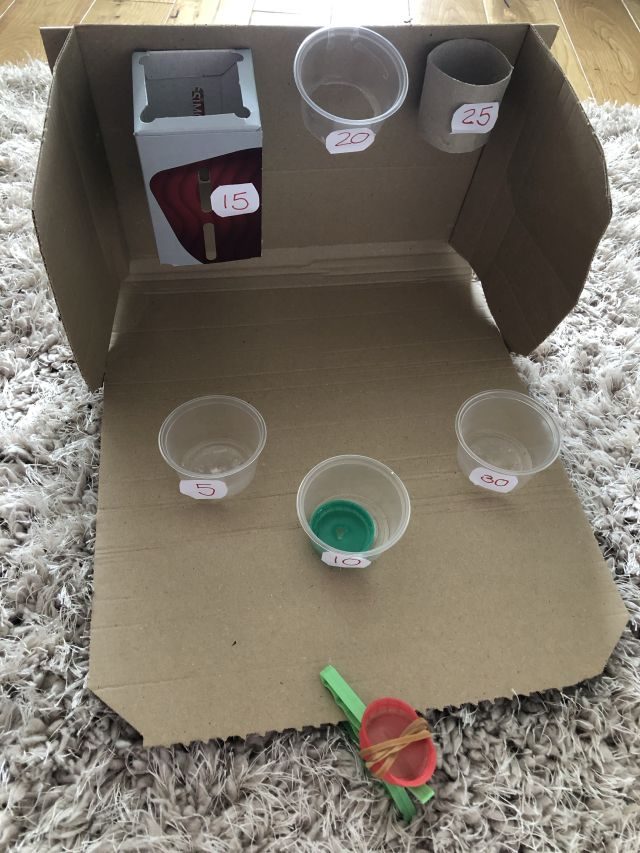
Find more information
https://www.scouts.org.uk/activities/lolly-stick-catapults/
Maze Game
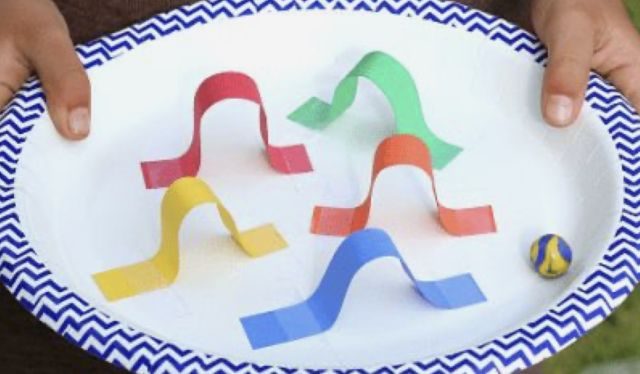 This game was fun to make and is great for building motor skills, concentration, counting and number recognition. Turn a cardboard box or plate into an entertaining ball maze game. This is a great hand-eye coordination game to make and play with reusable materials.
This game was fun to make and is great for building motor skills, concentration, counting and number recognition. Turn a cardboard box or plate into an entertaining ball maze game. This is a great hand-eye coordination game to make and play with reusable materials.
Suggestions of what you could use to make your own Recycled Maze Game:
Create the Maze
1) Design your maze by placing the tubes or paper strips on the box. Arrange them making sure you leave enough space for free ball travel around the maze.
2) Then attach the tubes or paper strips to your box or plate
3) ENJOY ! ! !
You could try these other ideas for making mazes too.
Here’s a fun song to help remind us of ways to cut down on single use plastic: https://www.bbc.co.uk/iplayer/episode/p0798jzc/junk-rescue-songs-2-single-use-no-thank-you
Don’t forget to share your creations on Google Classrooms or Twitter @GlenwoodFC #Glenwoodlearningathome
 Mrs Silvester has set you a challenge! Can you create your own dice game at home?
Mrs Silvester has set you a challenge! Can you create your own dice game at home?
Remember to share your ideas by tweeting @GlenwoodFC #Glenwoodlearningathome
Here are a few ideas to get you started…
The lids from milk jugs have been used to make these little Plastic Lid Ladybirds for a number dice game. To make the ladybird draw or use some button type eyes and pen dots on your lids. To Play the game, roll the dice and match the spots or numbers on the ladybird number lids to the dice.
What are dice good for?
Dice are great for introducing turn taking and encouraging early maths skills such as: counting, matching, comparing and number recognition.
Find some more number games on the CBeebies website by clicking the link below.
https://www.bbc.co.uk/cbeebies/joinin/numberblocks-help-your-child-with-maths

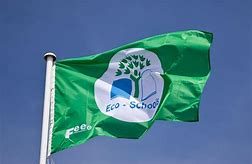 This year at Glenwood we have been investigating and exploring the environmental impact of litter. The children enjoyed many different activities including the story of Zack’s Journey (You can read it by clicking this link), mapping out how the litter travels from our local area to the wider environment and measuring the amount of single use plastic in lunch boxes.
This year at Glenwood we have been investigating and exploring the environmental impact of litter. The children enjoyed many different activities including the story of Zack’s Journey (You can read it by clicking this link), mapping out how the litter travels from our local area to the wider environment and measuring the amount of single use plastic in lunch boxes.
These are all things that you can continue to learn about at home. Eco-Schools Scotland shares some ideas on their website including:
One Planet Picnic – Have a picnic that’s good for you and good for the planet. Include healthy sustainable food with as little waste as possible.
Pop Up Pocket Garden – Design and grow a small garden at home in pots or outside. Celebrate Keep Scotland Beautiful’s birthday or the Year of Coasts and Waters with colourful and edible plants.
Fight Dog Fouling With Citizen Science – Have you noticed more dog fouling in your neighbourhood? We have! While out on your daily walk, can you help us with our survey work?
Count the number of bagged or unbagged dog poos you see (and why not take a photo?), post results on Twitter, Facebook or Instagram with #PooPost or #TurdTag and remember to always pick up after your own dog
Some ideas we do at nursery:





Remember to share your photos with us on Twitter by tagging @GlenwoodFC or by adding #glenwoodlearningathome 
Children are naturally scientists – their curiosity helps them to understand the world around them. The children at Glenwood love to do their own experiments – developing their skills of scientific inquiry and creativity as they work.
They ask questions and make predictions, follow instructions and make observations, developing skills for learning, life and work.
Here are a few simple experiments and investigations you can try at home…
Click on the link to find out how to Make a Bubble Snake
 Here is a reminder of the bubble mix recipe:
Here is a reminder of the bubble mix recipe:
1/2 cup of washing up liquid, 1 1/2 cups water & 2 teaspoons of sugar
You could use straws or other tubes to blow bubbles (or anything else with holes…)
Make a Paper Aeroplane (follow the link for instructions)
Which is the best design for flying fast?
Which goes the furthest?
Why don’t you have a competition with your whole family?
Create a Volcanic Eruption
This is a favourite at Glenwood – it can get messy so you might like to do it outside!
 First make your volcano – you could use an empty plastic bottle or yoghurt pot and some sand or mud.
First make your volcano – you could use an empty plastic bottle or yoghurt pot and some sand or mud.
Next put some bicarbonate of soda in the volcano (along with some ketchup or food colouring or paint to make the lava red)
Finally pour in some vinegar and watch the eruption!
Lego Boat Challenge
Can you make a boat that floats using Lego?
How many pennies can it hold before it sinks?
Another challenge for the whole family to get involved with!
Build a Bug Hotel
You could create a home for minibeasts in your garden – it can be big and fancy like the one on the RSPB website but a simple one using recycled materials will also attract wildlife.
Don’t forget there are some other science experiments in your Ideas for Home Booklet March 2020
Please Tweet some photos @GlenwoodFC #Glenwoodlearningathome